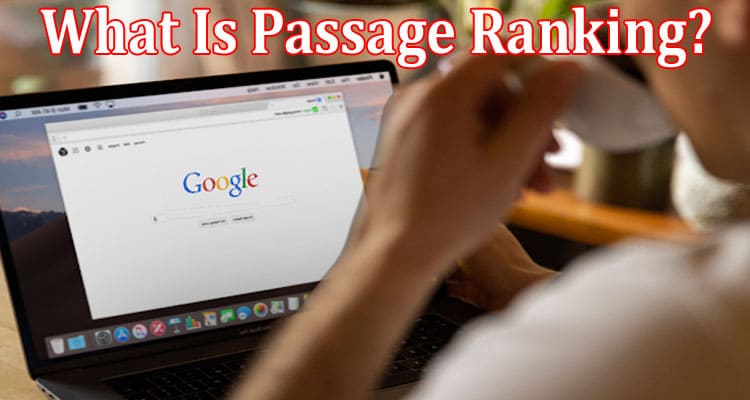What Is Passage Ranking?
Google’s announcement of “passage ranking” in 2021 on Twitter caused quite a stir within the digital marketing world and search engine optimization (SEO) industry. Google created passage indexing to make SEO easier for users who are not experts in the field. They update Google Search now and then and provide a list of additional algorithms. These updates help improve user experience and provide accurate search results.
How does Google Passage Ranking impact SEO? What is Passage Indexing? What does it do? How will these changes affect your website? These questions might be in your head right now. Read on to answer your questions.
Google Passage Ranking and Search Engine Optimization
While algorithm updates like passage ranking seem difficult to understand, they are simpler than other algorithm updates.
Passage indexing is an automated feature that shows users different sections of pages in a single search result. It will include a topic even if it is not the main topic the user has entered into the search engine.
What Is a Passage?
Experts define passages as short excerpts that answer a user’s question. For example, if a user searches for information about digital marketing, Google will show all results that include “digital marketing” as the primary keyword. Adding passage indexing allows Google to rank long-from content using synonym keywords or passages.
Passage indexing allows Google to independently rank different sections of content based on the keywords used. Examples of passages include searching for information and data on a topic. Google will provide a direct answer in different formats.
This additional feature gives users a broad overview of the entire content. Although the changes don’t significantly impact website traffic or overall ranking, the Google Passage Index is still an important factor to consider when creating content for search engine optimization.
According to SEO experts and digital marketing analysts, there is no reason to panic; these new features won’t affect your website’s traffic at all for the moment.
What is the difference between passage rankings and featured snippets?
Featured snippets make search engine optimization easier. They help a website rank at the top of search results, even without a high score. A website that appears in a featured snippet has a higher chance of people clicking on it.
It’s easy to confuse featured snippets with passage rankings. The passage index, however, is an entirely different feature. Google passages cover the page’s entire content, while featured snippets offer quick and simple answers.
How To Optimize Your Website for Google Ranking Changes and Passage Indexing
Passage indexing is a digital marketing strategy many are starting to consider. If you’re one of them, here are some ways to optimize your website for passage indexing and Google Ranking from experts in SEO in Arvada, CO:
Long-form Content
Long articles will improve your website’s ranking in search engine result pages (SERPs) because Google’s passage indexing will rank different keywords based on your content’s length. The longer your content, the more keywords you use that Google will individually rank.
However, how long does a passage have to be before Google considers it for indexing purposes? This question is not about the length of the text but how well organized it is with information and keywords. This can lead to trial and error since overly long content may overshadow the actual information.
It is important to plan and create authoritative content. Google will then consider your blog for passage ranking.
Passage Length
Google will consider your content for optimization in passage optimization if it is well-researched by your search engine optimization specialist and content creators. A 3000-word article should be divided into 1-2% of its passages. The length of your website will affect its Google ranking.
More Videos and Images
SEO experts recommend placing at least one image below each passage you intend to optimize. Google indexes websites with images and videos more often than without them. Modern-day blogging has become a standard practice. This is especially true if the website provides tutorials or reviews. Google will include images and videos this year in its ranking and indexing.
Optimized H tags
H tags, or heading tags, help optimize a website for passage ranking. Search engines use them to find your website. It’s important to include them if you want a higher rank in search engines.
Although it may seem like basic knowledge, remember that Heading 1 must have the highest importance. You should include the main keyword in Heading 1, and it should only be used once per page.
You should also be cautious with Heading 2 if you want Google to consider your content for passage indexing. If you use H2 to describe a passage, ensure it has latent semantic indexing keywords (LSI). Adding them will help Google understand your content’s context better.
Good Content
When creating content, there is one acronym that you need to remember: EAT, which stands for “Expert, Authoritative, and Trustworthy.” Quality content is factual and informative and answers many fundamental questions in the niche you’re targeting. As a content producer, you should be knowledgeable and concise with the information you share.
Google will rank your website higher if you have more informative and organized content. Make sure to research your topic extensively and have a clear outline before writing. Your website should always be considered the authority on a topic.
The Bottom Line
Passage ranking is a new tool from Google that helps make SEO easier for users, allowing Google Search to rank individual parts of your content individually. You can optimize your website using long-format long content, adding more videos and images, and maximizing H tags. Make sure to create good quality content that makes your website the expert in your chosen topic.




